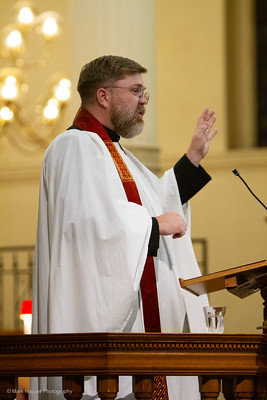Today, it is commonplace for us to think of Advent as the beginning of the Church’s year and the time of preparation for Christmastide’s celebrations. This is how we arrange our liturgical calendars and, at worship on the morning of the First Sunday of Advent, people are often heard wishing one another “Happy new year!” This is often done with a knowing smile, a gesture to the countercultural recognition of a new year that happens about five weeks before the civic new year. Advent is the beginning of the year and a familiar cycle of feasts and fasts, seasons, music, art, and traditions. But this has not always been the case. The placement of Advent in the Church’s year has varied over time leaving it, in the long view of history, neither here nor there. And perhaps this is particularly appropriate for this season.
Advent’s connection to Christmas seems impossible to separate. The season is filled with images of angels bearing news, John the Baptist’s prophecies, and stable-centred Nativity scenes with empty mangers, all pointing to the arrival of the Christchild on Christmas. Even the secular world has adopted Advent calendars, beginning on 1 December rather than the first day of Advent, marking the days to 25 December and the many celebrations observed on it. Advent also reminds us of Christ’s promise to come again, to return in glory and majesty on the last Day. This is especially apparent this season, in Year C of our current lectionary. On Christmas, even as we sing lullabies at the crèche, we remember Christ’s promise to return and complete the work begun so long ago.
With this deep connection between Advent and Christmas so firmly entrenched, it may seem strange to think of a time for Christians in the West when there was a midwinter season of preparation and waiting but had nothing to do with 25 December. In fact, before the year 380, there is no good evidence for the celebration of Christmas as its own feast day in the West, outside of Rome and parts of North Africa. For those first four centuries, the major midwinter feast for Western Christians was Epiphany on 6 January. The Epiphany celebration in those days had a broader scope than today and included the visit of the magi as well as the story of the Nativity and the Baptism of Jesus.
Being that Epiphany was such an important feast and full of associations with the presence of God among humanity, the coming of light in a time of darkness, and the baptism of Jesus, it was a popular day for the baptizing of new Christians. The tradition for many centuries—and still in some churches—was that feasts and baptisms were preceded by periods of fasting, prayer, and preparation. Epiphany was no exception, and it is likely that the origins of our Advent lie in this pre-baptismal preparation period.
Of course, while there may have been a general agreement among Christians about the importance of Epiphany and the need for preparation for the feast, there was no kind of uniformity about these practices. There are letters and records of pre-Epiphany feasts of 21 days, 40 days, 40-days-not-counting-certain-days-along-the-way which saw the fast beginning on 11 November, and many other variations aside. If you think today’s squabbles about the most appropriate colour for Advent are difficult, imagine the arguments about when to start the season!
At the end of the fourth century, the tradition of celebrating Christmas as a feast on 25 December, separated from Epiphany, began to spread through the West. Advent settled into its current form of four Sundays prior to Christmas around the year 600, courtesy of Pope Gregory I. In many places at this time, most notably powerful and influential Rome, it was the Christmas feast that marked the beginning of the Church’s new year. Advent was a heavily eschatological season, marking the end of the year, looking toward the end of time with the promise of Christ’s return. Indeed, for many generations Advent contained a thematic focus on the Four Last Things: Heaven, Hell, Death, and Judgement. A rather different sermon series than the now-common Peace, Hope, Joy, and Love!
While the length of the season is settled by Gregory I, its character is not quite what we imagine Advent to be. It seems to be understood as a season at the end of the year, before Christmas and its new year, rather than the pre-Christmas preparation that we think of. As with all our traditions, this changes over time. About 550 years later, Bernard of Clairvaux writes about Advent as a time of reflection on the coming of Christ, but he refers to three comings: past, present, and future. To paraphrase his reflection on these three moments: The first coming was visible when Christ was seen on earth and dwelt among humanity. The final coming will also be visible, and all people will see the glory and majesty of Christ. The second coming is invisible in power and spirit and lies between the first and third, like a road on which every Christian travels.
Here, in Bernard’s reflection, I think we have a clue about how to make the connection between the historical Advent and how we observe and keep the season today. Over the generations, Advent has been associated with Epiphany, Christmas, baptisms, different lengths of time, the end of the year, and now, the beginning of the year. We know a God who came once, whose spirit remains with us, and who has promised to come again; a God who makes all things new. While the historical changes of Advent may make it feel like a season that is neither here nor there, I cannot imagine a more fitting character for a liminal season, bridging years, kept by a people who walk together on the road between the first and final comings of Christ.






